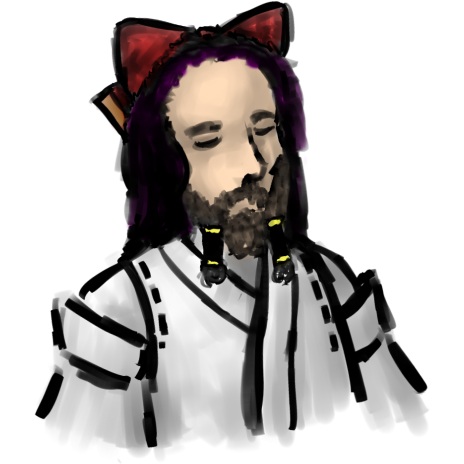- 📝 Posted:
- 🚚 Summary of:
- P0120, P0121
- ⌨ Commits:
453dd3c...3c008b6,3c008b6...5c42fcd- 💰 Funded by:
- Yanga
- 🏷 Tags:
Back to TH01, and its boss sprite format… with a separate class for storing animations that only differs minutely from the 📝 regular boss entity class I covered last time? Decompiling this class was almost free, and the main reason why the first of these pushes ended up looking pretty huge.
Next up were the remaining shape drawing functions from the code segment
that started with the .GRC functions. P0105 already started these with the
(surprisingly sanely implemented) 8×8 diamond, star, and… uh, snowflake
(?) sprites
,
prominently seen in the Konngara, Elis, and Sariel fights, respectively.
Now, we've also got:
- ellipse arcs with a customizable angle distance between the individual dots – mostly just used for drawing full circles, though
- line loops – which are only used for the rotating white squares around Mima, meaning that the white star in the YuugenMagan fight got a completely redundant reimplementation
- and the surprisingly weirdest one, drawing the red invincibility sprites.
The weirdness becomes obvious with just a single screenshot:

First, we've got the obvious issue of the sprites not being clipped at the
right edge of VRAM, with the rightmost pixels in each row of the sprite
extending to the beginning of the next row. Well, that's just what you get
if you insist on writing unique low-level blitting code for the majority
of the individual sprites in the game… 🤷
More importantly though, the sprite sheet looks like this:
So how do we even get these fully filled red diamonds?
Well, turns out that the sprites are never consistently unblitted during
their 8 frames of animation. There is a function that looks
like it unblits the sprite… except that it starts with by enabling the
GRCG and… reading from the first bitplane on the background page?
If this was the EGC, such a read would fill some internal registers with
the contents of all 4 bitplanes, which can then subsequently be blitted to
all 4 bitplanes of any VRAM page with a single memory write. But with the
GRCG in RMW mode, reads do nothing special, and simply copy the memory
contents of one bitplane to the read destination. Maybe ZUN thought
that setting the RMW color to red
also sets some internal 4-plane mask register to match that color?
![]()
Instead, the rather random pixels read from the first bitplane are then
used as a mask for a second blit of the same red sprite.
Effectively, this only really "unblits" the invincibility pixels that are
drawn on top of Reimu's sprite. Since Reimu is drawn first, the
invincibility sprites are overwritten anyway. But due to the palette color
layout of Reimu's sprite, its pixels end up fully masking away any
invincibility sprite pixels in that second blit, leaving VRAM untouched as
a result. Anywhere else though, this animation quickly turns into the
union of all animation frames.
Then again, if that 16-dot-aligned rectangular unblitting function is all you know about the EGC, and you can't be bothered to write a perfect unblitter for 8×8 sprites, it becomes obvious why you wouldn't want to use it:
Because Reimu would barely be visible under all that flicker. In comparison, those fully filled diamonds actually look pretty good.
After all that, the remaining time wouldn't have been enough for the next few essential classes, so I closed out the push with three more VRAM effects instead:
- Single-bitplane pixel inversion inside a 32×32 square – the main effect behind the discoloration seen in the bomb animation, as well as the expanding squares at the end of Kikuri's and Sariel's entrance animation
- EGC-accelerated VRAM row copies – the second half of smooth and fully hardware-accelerated scrolling for backgrounds that are twice the size of VRAM
- And finally, the VRAM page content transition function using meshed 8×8 squares, used for the blocky transition to Sariel's first and second phases. Which is quite ridiculous in just how needlessly bloated it is. I'm positive that this sort of thing could have also been accelerated using the PC-98's EGC… although simply writing better C would have already gone a long way. The function also comes with three unused mesh patterns.
And with that, ReC98, as a whole, is not only ⅓ done, but I've also fully caught up with the feature backlog for the first time in the history of this crowdfunding! Time to go into maintenance mode then, while we wait for the next pushes to be funded. Got a huge backlog of tiny maintenance issues to address at a leisurely pace, and of course there's also the 📝 16-bit build system waiting to be finished.
